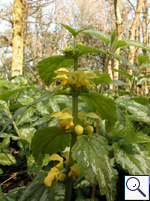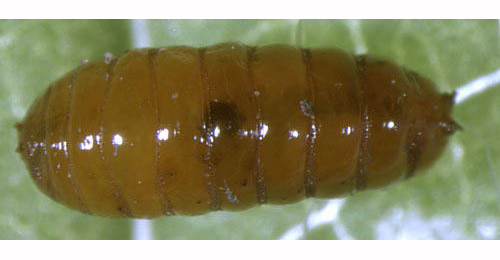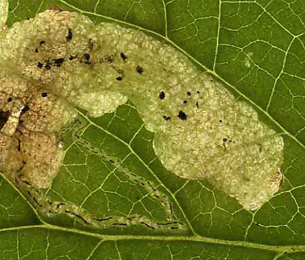|
||||||
|
LAMIASTRUM. Yellow Archangel. [Lamiaceae] |
|
|
Only one species of Lamiastrum, the native Yellow Archangel (L. galeobdolon), is recorded in Britain. Five British miners are recorded on Lamiastrum. See also Liriomyza species in Glasshouses and/or Quarantine Interceptions. A key to the European miners recorded on Lamium including Lamiastrum is provided in Bladmineerders van Europa. |
 Yellow Archangel Lamiastrum galeobdolon |
Key for the identification of the known mines of British |
1a > Leaf-miner: A distinctive mine primarily above mid-rib, with irregular short lateral offshoots into leaf blade. Pupation external (Spencer, 1972: 51 (fig. 172), 55; Spencer, 1976: 270, 271 (fig. 486)). Branched, whitish, upper-surface corridor; main axis overlying the midrib; side branches overlying the main lateral veins. (In Campanula and Phyteuma the mine is much less branched, sometimes nothing more than a corridor on top of the midrib). Frass in rather long strings. Usually the mines begins as a long and narrow, shallow, tortuous lower-surface corridor that ends upon the midrib but otherwise is not associated with the leaf venation. Often this initial corridor is filled with callus, and then even less conspicuous. Pupation outside the mine. A linear mine on the upper surface, usually following the midrib and showing side branches along the veins. The frass is in strings. |
|
Liriomyza strigata (Meigen, 1830) [Diptera: Agromyzidae]. |
| 1b > Leaf-miner: A
blotch-mine invariably adjoining margin of leaf (Spencer,
1976: 110, fig. 105).
Upper-surface, yet rather deep, therefore quite transparent, blotch, always along the leaf margin, generally in the distal half of the leaf. The blotch is preceded by a short and broad corridor, most of the time overrun later. Four to eight larvae may co-occur in a leaf. Pupation outside the mine, exit slit in lower epidermis. Puparium reddish brown or reddish-orange |
|
| Agromyza flavipennis Hendel, 1920 [Diptera: Agromyzidae]. |
1c > Leaf-miner: An initially linear mine, which at second instar develops into a large whitish blotch with conspicuous black frass. The early linear mine is frequently entirely enveloped by the blotch but is detectable by the alternate irregular strips of frass. Pupation external (Spencer, 1976: 158). The first part of the mine consists of a long, slender upper-surface corridor. After the first moult this changes into a large primary blotch without feeding lines. Frass in the corridor in short, somewhat angular thread fragments, towards the end even in grains. Frass arranged less closely along the sides than in A. lamii. Pupation outside the mine. The frass is conspicuous in the mine and the mine is initially linear, then develops into a white blotch, often enveloping this early mine. |
|
Amauromyza morionella (Zetterstedt, 1848) [Diptera: Agromyzidae]. |
1d > Leaf-miner: A linear-blotch mine, first instar mine is linear, later developing into a conspicuous white blotch. Frass greenish diffused (Spencer, 1972b: 46, 47 (fig. 138); Spencer, 1976: 166). The mine begins with a long, upper-surface, slender corridor. After a moult the larva changes its behaviour, and makes a large, upper-surface primary blotch without apparent feeding lines. Often the blotch overruns more or less the initial corridor. Frass in the corridor liquified to form a wide green band, with a few tiny black granules along the sides. Pupation outside the mine. A narrow gallery leading to a largish blotch on the upper surface. Frass is green and indistinct in the gallery - small grains may be seen at the gallery edge. |
 Amauromyza labiatarum puparium Image: © Willem Ellis (Bladmineerders van Europa) |
|
Amauromyza labiatarum (Hendel, 1920) [Diptera: Agromyzidae]. |
1e > Leaf-miner: Initially a long, slim corridor, the frass alternating on either the side of the corridor. After moulting, the larva broadens the mine and the frass is less regular. Pupation external. |
 Mine of Amauromyza lamii on Stachys sylvatica Image: © Willem Ellis (Bladmineerders van Europa) |
|
Amauromyza lamii (Kaltenbach, 1858) [Diptera: Agromyzidae]. |
1f > Leaf-miner: Rather long corridor winding through the leaf, regularly crossing itself. The corridor later widens considerably. Frass normally in a narrow central line, but may also lie along the side, or be absent. The larva regularly leaves a mine and restarts elsewhere. |
|
Apteropeda globosa (Illiger, 1794) [Coleoptera: Chrysomelidae]. |
| Last updated 05-Jul-2019 Brian Pitkin | ||
